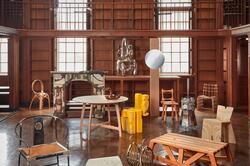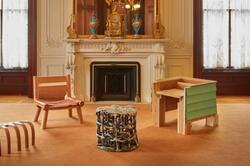Objects May Shift
SALONE DEL MOBILE 2024
APRIL 16 - 21, MILAN, ITALY
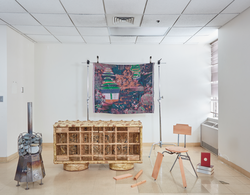
Ideas May Shift
Perspectives May Shift
Worlds May Shift
Futures May Shift
Topics in Exhibition is an intensive studio course at Rhode Island School of Design (RISD). Variously a group critique, an idea accelerator, a collective curatorial experience, an expression of a single thematic idea in diverse media and a workshop in which to formally refine visual and material concepts, Topics in Exhibition offers students an opportunity to design and produce a multidisciplinary exhibition for the international stage.
Comprised of 20 students from seven distinct disciplines including Ceramics, Furniture Design, Glass, Graphic Design, Industrial Design, Interior Architecture, and Textiles, the 2024 Topics in Exhibition course explores our ever-evolving relationship to—and experience of—the interior. Co-directed by Anais Missakian (Pevaroff-Cohn Family Endowed Chair in Textiles) and Pete Oyler (Associate Professor, Furniture Design), the resulting exhibition—Objects May Shift—is part of the 2024 Satellite Salone at the Salone del Mobile in Milan, Italy.
A prompt to recontextualize the ordinary and find surprise in the unexpected, Objects May Shift is a curious and critical exploration of how our world and the ways that we inhabit it are changing. From graphic design to art, furniture and textiles, the exhibition foregrounds creative flux and transgresses disciplinary tradition. A variable typeface is scaled to excess, skewed and outlined; an upholstered seat inflates to become a wall; a cabinet is made from a dresser; and a woven Jacquard tapestry pairs AI-generated imagery with images of wealth, hoarding and trash. The exhibition is as imaginative and optimistic as it is sobering.
The production of Objects May Shift was a highly collaborative effort and we would like to thank everyone who helped bring this exhibition to life. Special thanks to: the Office of the President, Office of the Provost, Divisions of Fine Arts and Architecture and Design, and the Office of Graduate Studies.

THE KNIT WIGGLE
YUKTI V. AGARWAL
Canvas, cotton, elastomeric yarns, merino wool, nylon ripstop
Deflated: L 30” - W 20” - H 18"
Inflated: L 30” - W 25” - H 60"
The Knit Wiggle is a modular inflatable that transcends traditional boundaries of static furniture, creating flexible spaces out of thin air. In its resting state, this inconspicuous cushioned bench is a warm and inviting place for community dialogue. Within seconds, the bench expands into a dividing wall that builds private and intimate spaces. As it inflates, a hidden landscape is revealed in the knitted upholstery, encouraging moments of mindfulness and wonder. Multiple walls can nestle together, making an adaptable division of space. Designed for creative collaboration and innovation, the Knit Wiggle reimagines the future of interiors—dynamic, intriguing and ever-evolving.
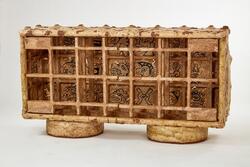
COUNTING THE DAYS CREDENZA
SAMUEL AGUIRRE & TONY TORRES
Ash wood, bronze, cornstarch, glass, mulberry fiber, post-consumer paper pulp
L 19” - W 60” - H 30"
This environmentally conscious credenza utilizes natural and recycled fibers and an ancient Amate papermaking technique, and showcases hand-painted Mesoamerican imagery from the Tōnalpōhualli. The artists, Samuel Aguirre and Tony Torres, first met in 2023 during a papermaking class, inspiring Samuel to explore 3D objects rooted in traditional papermaking. Tony, a Chicano artist, integrates the Amate technique into his work to illuminate Mesoamerican history. This interdisciplinary project merges future furniture design with historical practices, resulting in a symbolic Counting the Days Credenza.

CHAIR 03, AMATE
SAMUEL AGUIRRE & TONY TORRES
Cornstarch, cotton, mulberry fiber, post-consumer paper pulp
L 24” - W 26” - H 36"
This environmentally conscious chair utilizes natural and recycled fibers, an ancient Amate papermaking technique. The artists, Samuel Aguirre and Tony Torres, first met in 2023 during a papermaking class, inspiring Samuel to explore 3D objects rooted in traditional papermaking. Tony, a Chicano artist, integrates the Amate technique into his work to illuminate Mesoamerican history. This interdisciplinary project merges future furniture design with historical practices, resulting in a symbolic Chair 3, Amate.
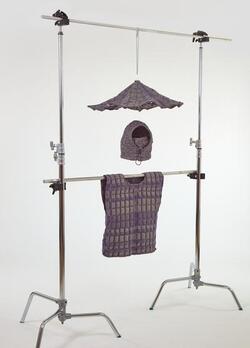
WOVEN BINARIES: I. PHYSICAL, II. VERBAL, III. CYBER
ISABELA CHAN
Cotton, cord, metal, reflective yarn
L 26” - W 26” - H 47"
Woven Binaries: I.Physical, II.Verbal, III.Cyber displays the quantification of human experiences and the dilution of emotional qualities through their simplification into binaries. The three parts to this metaphorical garment refer to the physical, verbal and cyber categorizations of discrimination in Brazilian law, materializing them into tangible forms that explore the relationship and boundaries between the body, its social context and the physical environment.
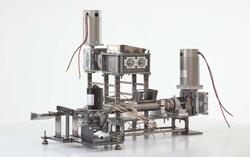
THE GREAT CHAIN OF BEING
JONATHAN DINETZ
Mild steel, aluminum, bronze, HDPE
L 26” - W 14” - H 53.5”
The Great Chain of Being is a mechanical assurance of the birth, life and ultimate dissolution of our bodies and consciousness. Using hallmarks of our current modes of industry like storybook characters, this piece seeks to dislodge the presumed anthropocentric authority to manipulate Earth as we see fit. It reminds us that over a long enough timeline, all evidence of our existence will be erased. It suggests that rather than trying to fight this inevitability, we embrace it and exercise empathy toward the landscape we inhabit, tending to it rather than living in opposition.
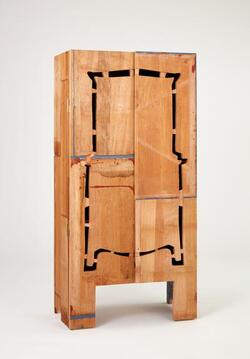
CABINET I
YUXUAN HUANG
Paint, wood
L 26” - W 14” - H 53.5”
Cabinet I is made from the deconstructed materials of a found dresser. Reversing the original dresser inside out, and maintaining all the marks of usage, Cabinet I is a tale of the unknown craftsman, the life of an old object, and a time capsule transformed into a cabinet of curiosities. This piece is part of the artist’s ongoing series, Lost Stories, featuring a deconstructive reimagination of antique furniture and passing on the stories of objects that have been lost in time.

FOOL ME THREE TIMES
CHRISTINE JUNG
Glazed stoneware
Length may vary, L 48” - W 58"
Fool me three times embodies the experience of asking for empathy in an exploitative environment. The duck represents the artist’s initial years as a nanny, when they experienced injustices shared by many domestic workers: wage theft, casual racism, classism, sexism and difficulty advocating for indirect compensation including guaranteed pay, paid sick leave and a healthcare stipend. In its full length, the reflection pool holds the viewer at a distance from the sitting duck, forcing them to recognize their separation in understanding and empathy. The viewer can walk away when they want while the duck has to wait—eternally at the mercy of those who couldn’t care less.
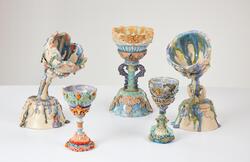
ONE
JAEWON KIM
Glazed paperclay
Small Holy Grail: L 3.9” - W 4.7’ - H 8.2"
Medium Holy Grail: L 4” - W 5” - H 8.2"
Medium Holy Grail: L 5” - W 7.5” - H 15"
Tall Holy Grail: L 8” - W 9” - H 15"
By placing a religious artwork, a space becomes meaningful. Regardless of its size and shape, conceptually religious artwork allows a place to become associated with religion. More specifically, people identify with the object and question or think about their religious beliefs. By putting meaning and concepts into a piece of art, ONE aims to arouse curiosity in the viewer and convey a sense of familiarity with religious art. In addition, the visual effects of the artwork—the shape, color, glaze, etc.—are correlated with the interior, so that the space and the artwork are seen as ONE art.
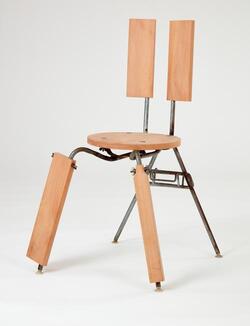
THE WASHED UP HERMAN MILLER CHAIR
CAMERON LASSON
Found Herman Miller shell chair legs, sycamore
L 18” - W 18” - H 48”
The Washed Up Herman Miller Chair was made using sycamore from the property of the Deepree Home-- designed by Charles and Ray Eames-- for the first CEO of Herman Miller, along with a modified Herman Miller Shell base. The wooden parts are kept suspended within the metal frame, highlighting the contradiction between the standardized, mass-produced legs and the handmade, wooden components that symbolize the alienation of materials in an industrial context. This chair is assembled within 340 seconds, the same amount of time as a Herman Miller Aeron Chair, which is considered a miracle of American industry.

SAUNA STOVE
CAMERON LASSON
Mild steel, sea stones
L 18” - W 18” - H 48”
Sauna Stove considers the soul that might inhabit this piece during—and after—years of use. The patina is a naturally occurring oxidation that exists on the metal surface when fire is burned inside, a physical manifestation of the spirit of the stove. It was designed in consideration of the contradictions between the industrial and traditional, and inspired by manufactured objects like the Moka Pot, the Smokey Joe Barbeque and the traditionally crafted, wood-fired sauna stove.

TERMITE STOOL
SARAH ALIX MANN
Black walnut
L 15” - W 15” - H 16"
How would you feel stepping onto a stool that looks decayed—even if it is perfectly capable of bearing weight? What about furniture riddled with termite paths, a sign it should be removed? The Termite Stool uses 3D scanning and CNC milling to emulate the patterns left by termite damage, in an exploration of “decomposing” objects within the home. Nature and technology took turns in this process, flipping creation and decay, the difficulty of fighting termites with the difficulty of replicating their effects, and the energy termites generate by eating wood versus the energy expended to carve out the stool.
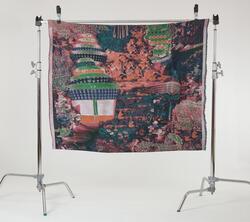
UNTITLED (HOARD)
SOPHIE MEYER
Cotton, linen, polyester, wool
L 108” - H 108"
Untitled (Hoard) is both an homage to historical textile practices and a distortion of the traditional expectation of the interior. Collaged images of rich tapestry and wealth intermingle with images of hoarding, trash and AI-generated imagery to overwhelm the viewer and call into question an object’s value within the space it inhabits. What makes interiors fundamentally different if not the way individuals interpret their value? This piece does not ask for answers, but creates an environment that invites the viewer to pause and enter moments of familiarity, further questions and uncertainty.
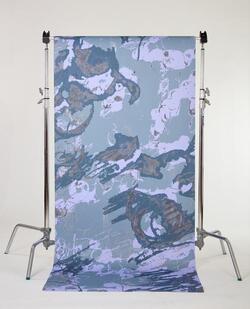
CARBONILLA COMO ORIGEN
MAUREEN SCALLY
Wallpaper
L 115” - H 109"
Carbonilla como Origen (Charcoal as Origin) is inspired by a series of photographs the artist took on a visit to Argentina in 2023. From airport terminals to a Pachamama ceremony, these images speak about a trip she had been dreaming of since 2019. The artist used tracing paper and charcoal to create drawings that landed gracefully into this layered, entangled and complex pattern. The wallpaper speaks about saying hellos and goodbyes to loved ones, it enunciates the tension between the frustration and gratitude that she feels as a migrant.
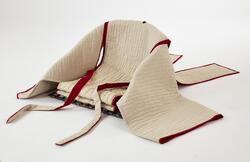
JIEYU CHAIR
ZIYAN WANG
Cotton, mild steel
L 40” - W 40” - H 18"
The Jieyu Chair is a performative seat; its traditional Han garment upholstery unveils itself as the user stands, leaving only the chair's skeletal frame. Embedding a unique cultural memory, it draws narratives from the poetry of Jieyu Ban, symbolizing historic Chinese female experiences within royal households. The performative process involved in activating the piece dismantles past narratives, replacing them with an alternative story shaped by contemporary female perspectives.
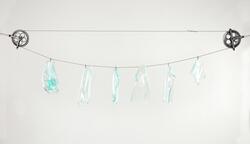
DIRTY LAUNDRY: SOIR D'ÉTÉ
KODA ADELINE TOUSIGNANT
Glass, pulleys, steel cable
L 12” - W 5” - H 4"
L 11” - W 4” - H 2"
L 10.5” - W 7.5” - H 7"
L 12” - W 6” - H 6"
Dirty Laundry serves as an introduction to the 1970s October Crisis and a recollection of the domestic tasks that kept people safe while the military took to street corners. Each piece of the glass "laundry" is sandblasted with hand-cut stencils that feature writing that either referred to, or stemmed from, this point of time and remains pertinent to the ever-evolving state of Franco-Anglo relations in Canada.
Works Quoted: Michele Lalonde, "Speak White," 1974; Pierre Trudeau, “Just Watch Me” speech, 1970; Emile Nelligan, "Soir d’hiver," 1889; Alain Brouillard, “Testimony of Recruitment,” 1963; Bernard Adamus, “Cauchemar en cours,” 2009.
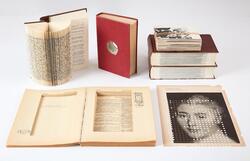
EXPLOSION PIECE
REBECCA WILKINSON
Used library books
Dimensions Vary
Explosion Piece is an installation of physical interventions:
1. Begin with an existing object.
2. Blow it up, but let the newly separate parts keep their meaning.
3. Collect the fragments.
4. Reassemble them to create something new.
Each book once served as an archive—a furniture encyclopedia, an antique collection catalogue, a museum inventory list—that was deconstructed or transformed. This new, intervened archive questions how meaning can be (re)made when texts and images are reassembled. It interrogates the book as an artifact, exploring the human impulse to make sense of the world.
Connect with RISD FD
For press inquiries, please contact:
Jaime Marland
RISD Public Relations
401 427-6954
jmarland@risd.edu
For information on specific works, please contact:
Stephanie Darling
Furniture Design Department, RISD
sdarling@risd.edu

